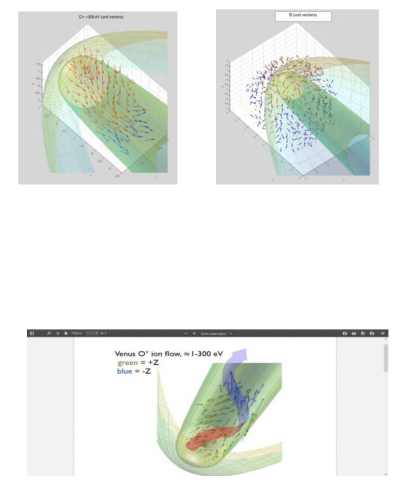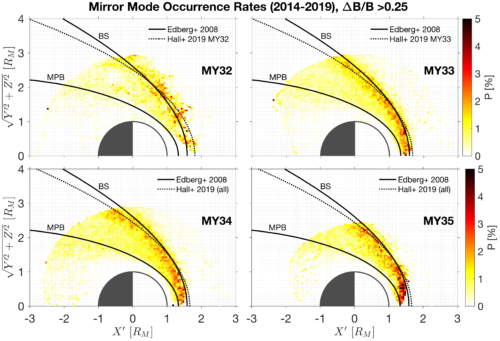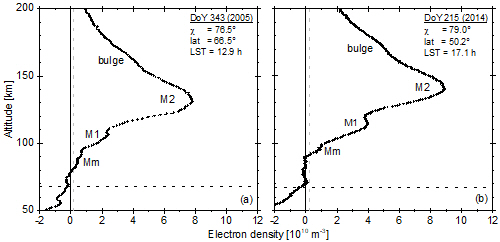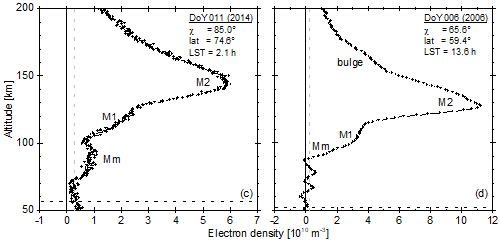The thermal electron temperature is an important parameter for planetary ionospheres because it drives several important processes in the photochemical region of the atmosphere. Various electron-neutral collision and ion dissociative recombination rates depend on the thermal electron temperature, which thus strongly influences the structure and composition of the ionosphere. The production of hot neutral atoms via the dissociative recombination of molecular ions (in particular O2+ to hot O) can drive atmospheric escape to space, and the thermal electron temperature is thus also important for the long term evolution of the Martian atmosphere.
Multiple studies have attempted to model the thermal electron temperature profile at Mars but have been unable to match observations. A topside heat flux from the solar wind interaction with Mars is typically invoked in these models to bring modeled temperatures into agreement with observations [1, 2, 3, 4]. The similar scale size of the Martian magnetosphere with respect to the proton gyro radius in the upstream solar wind has long been posited as a facilitator for efficient wave-particle interactions between waves generated at the Martian bow shock, and charged particles in the topside ionosphere, to provide this topside heat flux [5, 6]. However, detailed observations of the relevant plasma characteristics required to investigate such wave-particle interactions in detail have been lacking at Mars, until the arrival of the Mars Atmosphere and Volatile EvolutioN (MAVEN) mission in the fall of 2014.
We present here MAVEN observations of such wave-particle interactions, driven by periodic (~ 25 s) large scale (100s km) magnetosonic waves propagating from the shock/sheath region into the Martian dayside upper ionosphere. These waves adiabatically modulate the suprathermal electron distribution function, and the induced electron temperature anisotropies drive the generation of observed electromagnetic whistler waves. The localized (in altitude) minimum in the ratio fpe / fce provides conditions favorable for the local enhancement of efficient wave-particle interactions, so that the induced whistlers act back on the suprathermal electron population to isotropize the plasma through pitch angle scattering. These wave-particle interactions break the adiabaticity of the large scale magnetosonic wave compressions, leading to local heating of the suprathermal electrons during compressive wave `troughs'. Further evidence of this heating is observed as the subsequent phase shift between the observed perpendicular-to-parallel suprathermal electron temperatures and compressive wave fronts. Full details are presented in [7].
Because the primary heat source for thermal electrons in the Martian ionosphere is heating via collisions with suprathermal electrons [8, 9], the above heating mechanism may thus play an important role in driving the enhanced thermal electron temperatures that have long been reported in the upper ionosphere of Mars. Such a heating mechanism may also be important at other unmagnetized bodies such as Venus and comets.
[1] Hanson, W. B., & Mantas, G. P. (1988). Viking electron temperature measurements: Evidence for a magnetic field in the Martian ionosphere. Journal of Geophysical Research: Space Physics, 93(A7), 7538-7544.
[2] Chen, R. H., Cravens, T. E., & Nagy, A. F. (1978). The Martian ionosphere in light of the Viking observations. Journal of Geophysical Research: Space Physics, 83(A8), 3871-3876.
[3] Choi, Y. W., Kim, J., Min, K., Nagy, A. F., & Oyama, K. I. (1998). Effect of the magnetic field on the energetics of Mars ionosphere. Geophysical research letters, 25(14), 2753-2756.
[4] Cui, J., Galand, M., Zhang, S. J., Vigren, E., & Zou, H. (2015). The electron thermal structure in the dayside Martian ionosphere implied by the MGS radio occultation data. Journal of Geophysical Research: Planets, 120(2), 278-286.
[5] Moses, S. L., Coroniti, F. V., & Scarf, F. L. (1988). Expectations for the microphysics of the Mars‐solar wind interaction. Geophysical Research Letters, 15(5), 429-432.
[6] Ergun, R. E., Andersson, L., Peterson, W. K., Brain, D., Delory, G. T., Mitchell, D. L., ... & Yau, A. W. (2006). Role of plasma waves in Mars' atmospheric loss. Geophysical research letters, 33(14).
[7] Fowler, C. M., Agapitov, O. V., Xu, S., Mitchell, D. L., Andersson, L., Artemyev, A., ... & Mazelle, C. (2020). Localized Heating of the Martian Topside Ionosphere Through the Combined Effects of Magnetic Pumping by Large‐Scale Magnetosonic Waves and Pitch Angle Diffusion by Whistler Waves. Geophysical Research Letters, 47(5), e2019GL086408.
[8] Fox, J. L., & Dalgarno, A. (1981). Ionization, luminosity, and heating of the upper atmosphere of Venus. Journal of Geophysical Research: Space Physics, 86(A2), 629-639.
[9] Torr, M. R., Richards, P. G., & Torr, D. G. (1980). A new determination of the ultraviolet heating efficiency of the thermosphere. Journal of Geophysical Research: Space Physics, 85(A12), 6819-6826.
